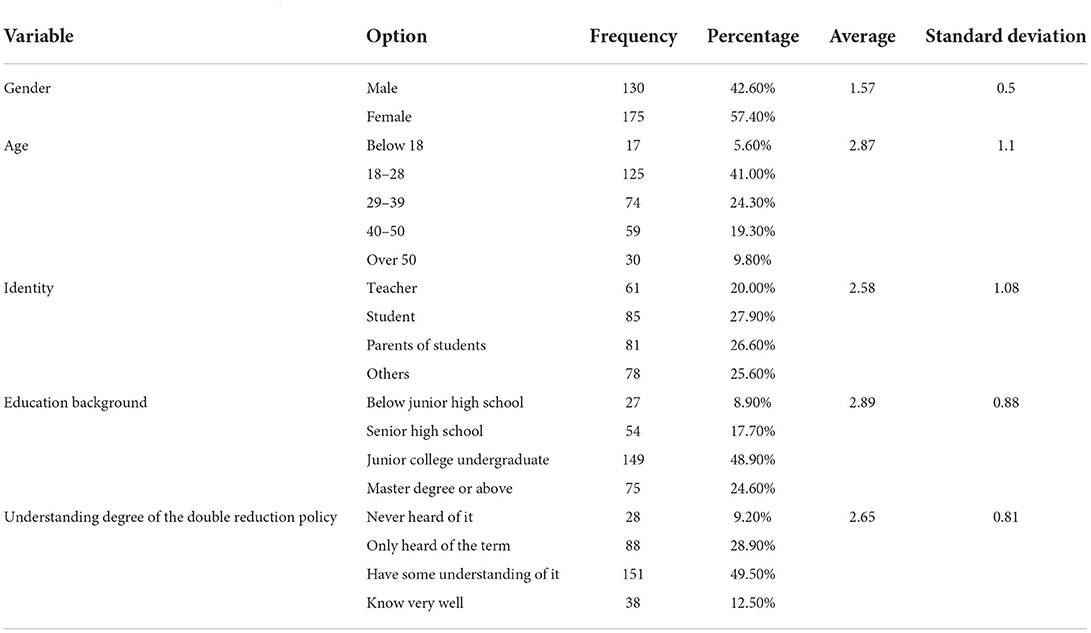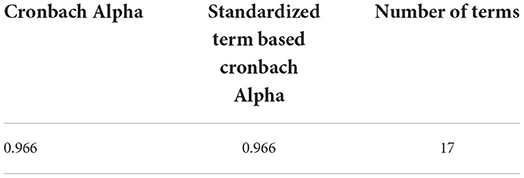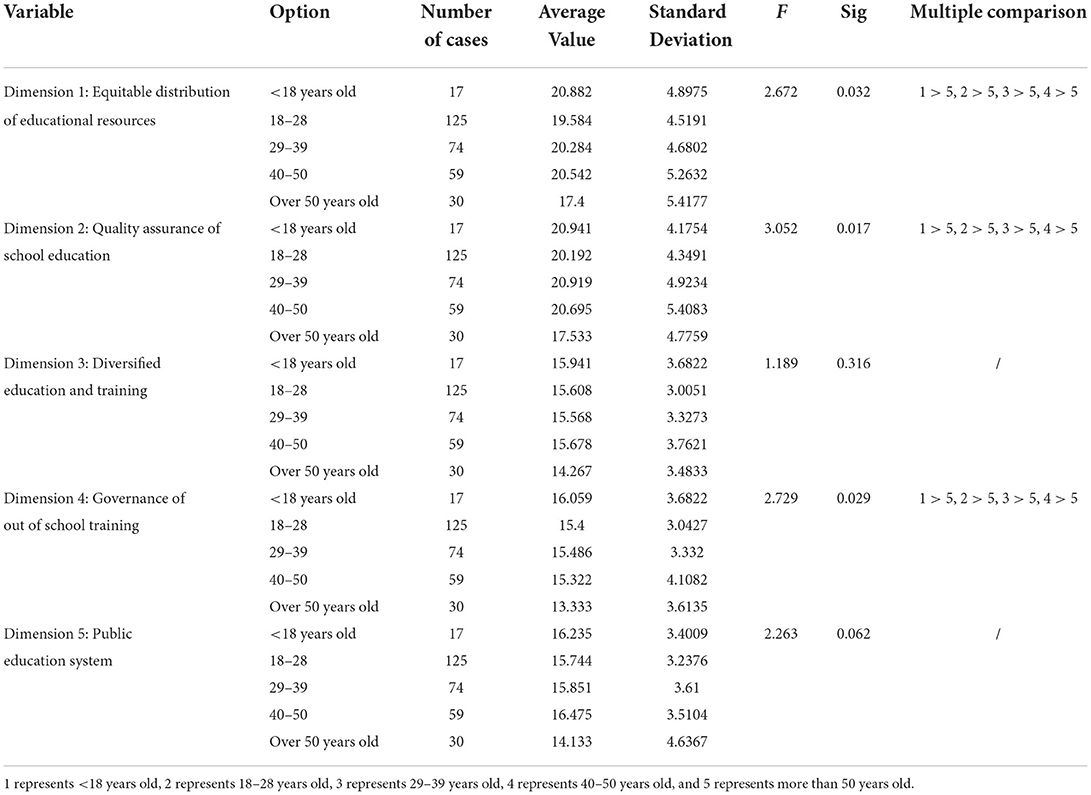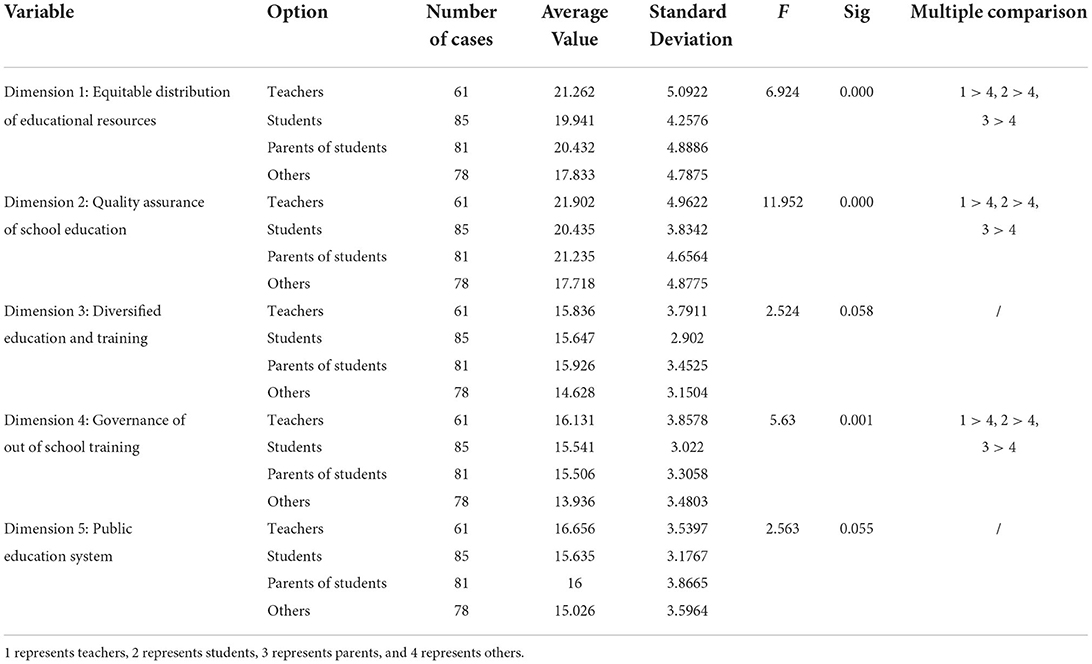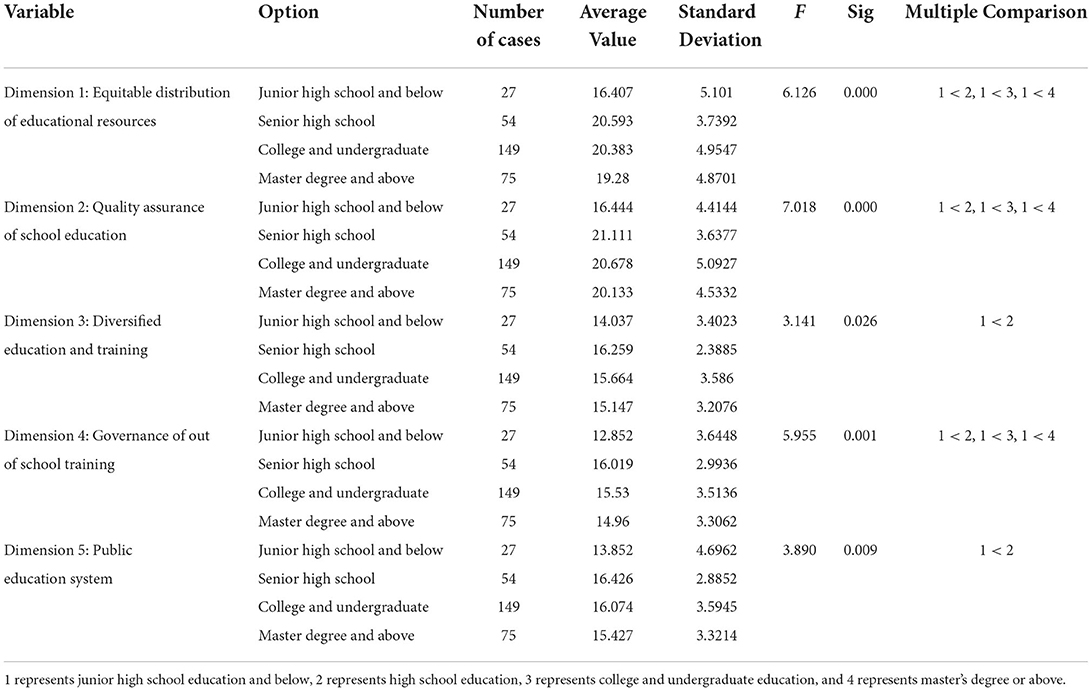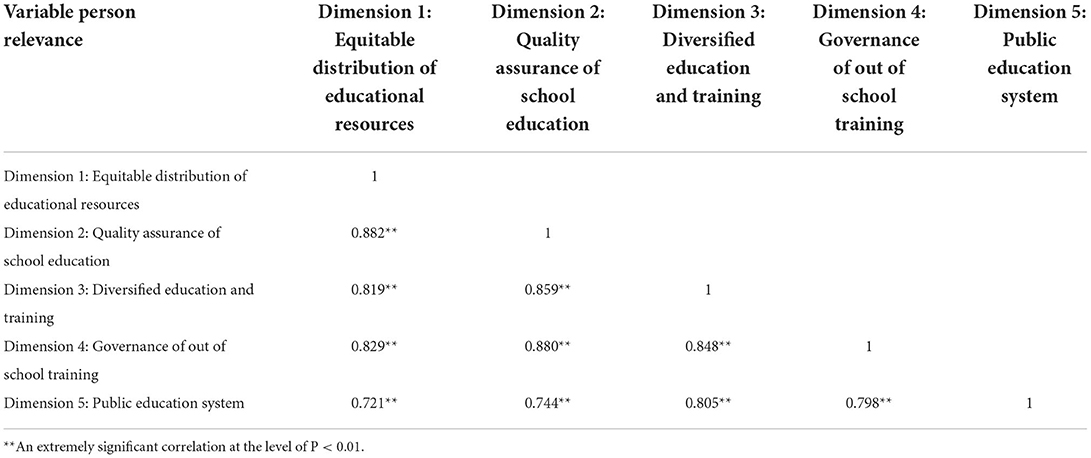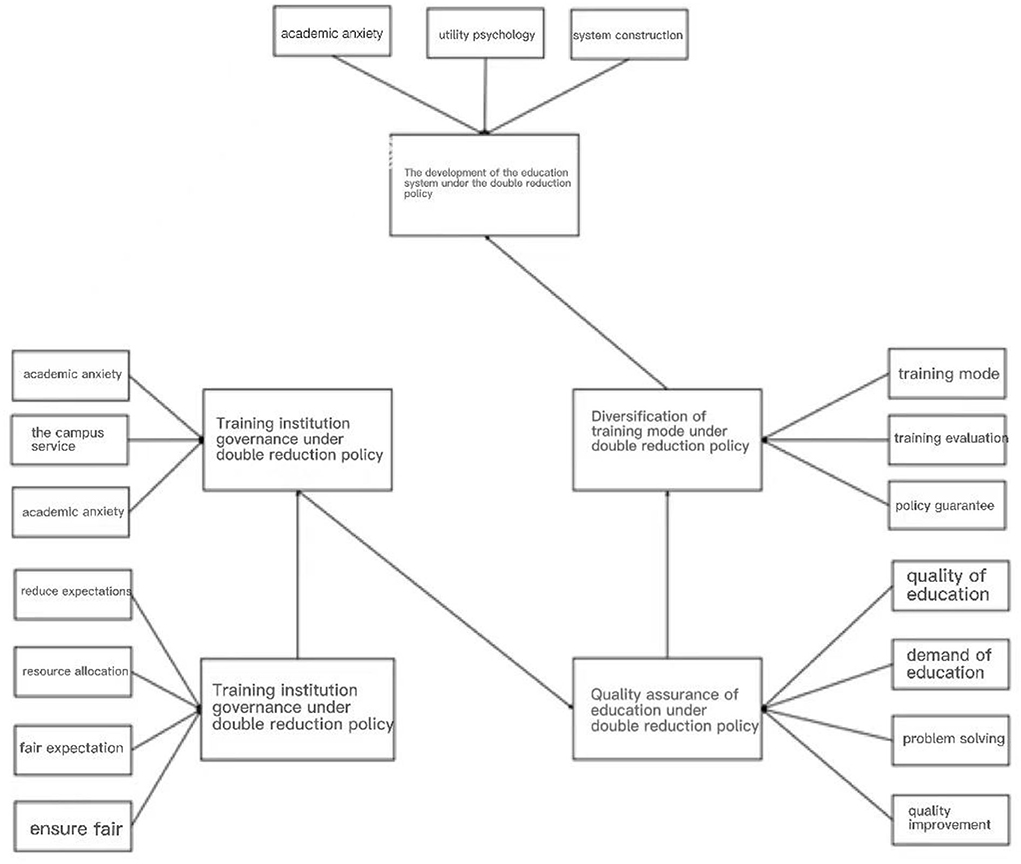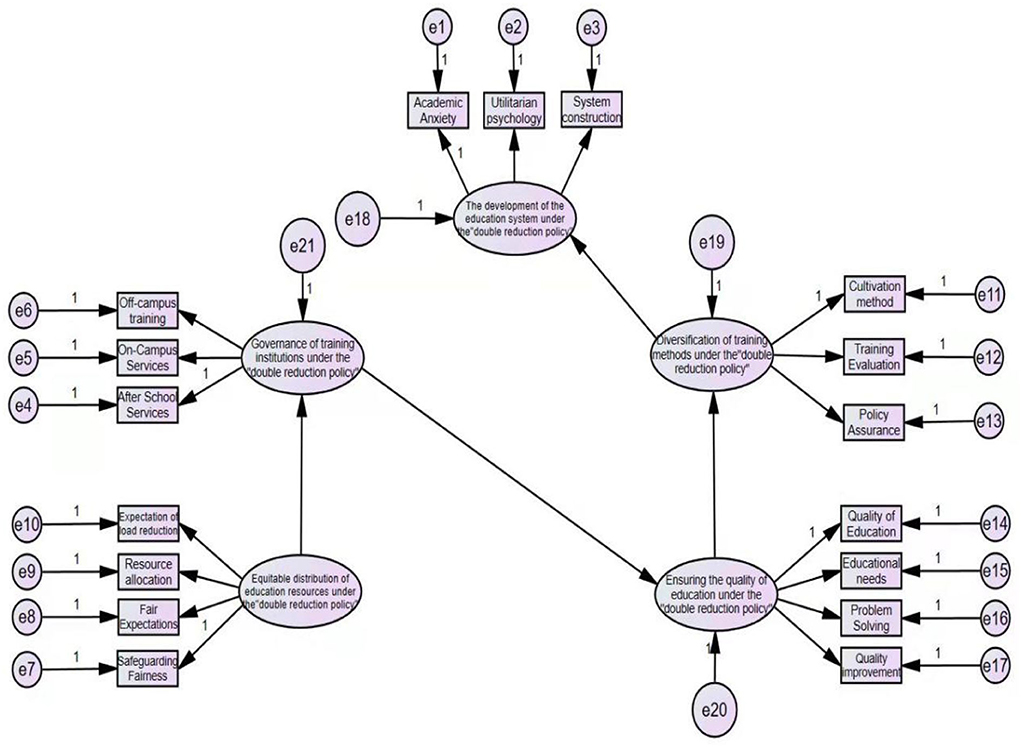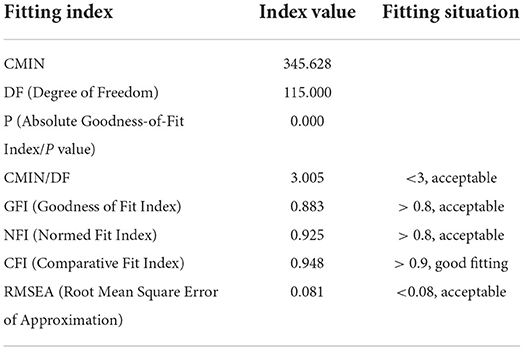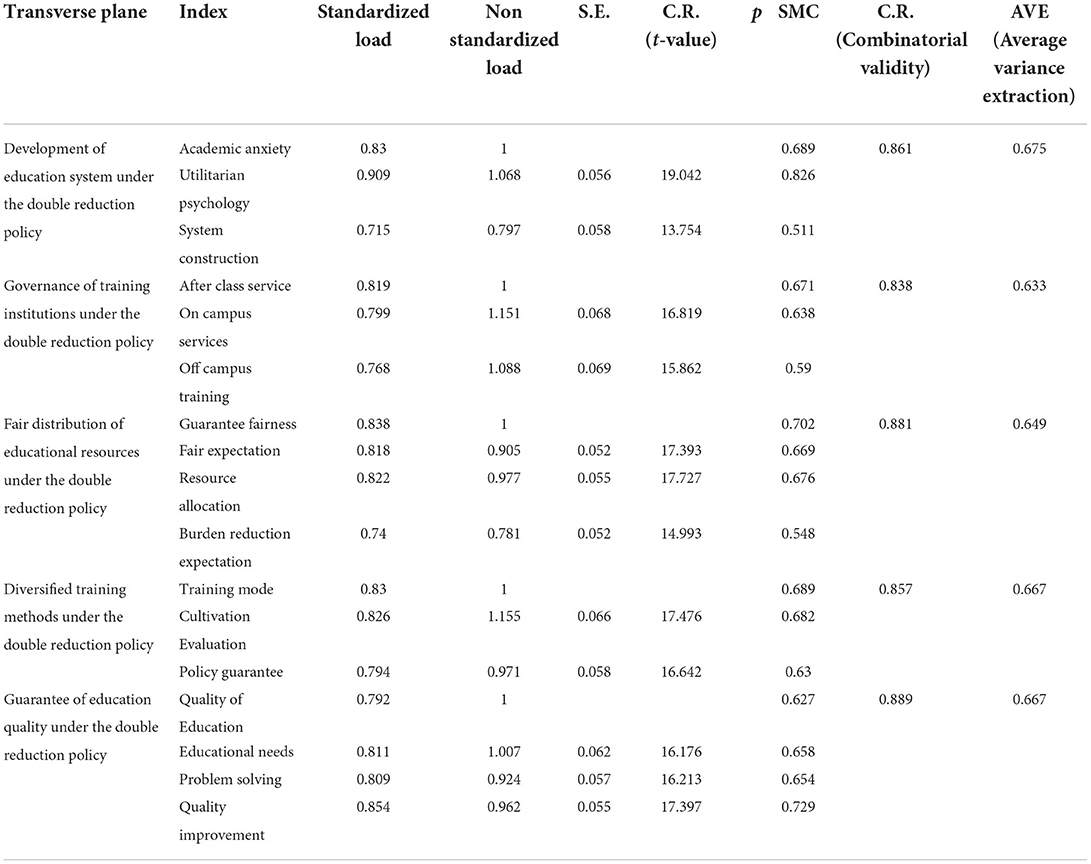- 1School of Foreign Languages, Changchun University, Changchun, China
- 2School of Cyber Security, Changchun University, Changchun, China
To effectively reduce the homework burden and off-campus training burden of students in the compulsory education stage in China, China adopts the double reduction policy to carry out corresponding governance in the field of education. This study aims to explore the public's psychological cognition of the current education system under the implementation of the double reduction policy. The public's opinion data on education concepts under the implementation of the double reduction policy are collected, then the SPSS software and Amos software to quantitatively analyze the public's educational concept data are used, and a corresponding structural model equation to analyze the public's opinion on the implementation of the double reduction policy is established. The psychological concepts of all aspects of education are observed, the public's psychological views on education under the implementation of the double reduction policy are finally obtained, the ideological connotation of popularizing the double reduction policy for the general public is provided, and the balanced development of the domestic education system for the implementation of the double reduction policy is ensured. Two suggestions are made in order to provide a corresponding reference for the public's psychological cognition research on the current education system under the implementation of the double reduction policy.
Introduction
In July 2021, China promulgated the “Double Reduction Policy”, which was deployed to solve the problem of excessive homework burden and off-campus training burden on students in China. It aims to prevent China's education system from being invaded by capital, monopolize China's education resources, and then subvert China's education system. To this end, China has implemented the “double reduction policy” (Zhang, 2021) to reconstruct and manage the current public education system, remove the capitalization of the current education system, ensure the education fairness of the Chinese people, and rebuild the public's understanding of public education. The educational psychology of the system.
To explore the psychological cognition of the public about the current education system under the implementation of the double reduction policy in the field of education in China, this study first uses a questionnaire to investigate the public's educational resources, on-campus teaching quality, and education under the implementation of the double reduction policy. The training direction, the governance of off-campus training, and the opinion data of China's public education ecosystem are collected, and the public's educational psychological concept under the implementation of the double reduction policy is quantified through the structural model equation, which has been implemented in China's education field. After the double reduction policy, the public's psychological cognition toward the education system, and finally, according to the public's psychological cognition toward the education system, corresponding substantive suggestions for the implementation of the double reduction policy are put forward, so as to provide empirical evidence for the subsequent double reduction policy. The research provides a reference to the corresponding academic achievements.
Literature review of education ideas under double reduction policy
The reform of educational psychology under the double reduction policy
The “double reduction policy” reforms the education system in and out of school in order to lead the whole society to change the psychological concept of education, promote schools to play the main function of teaching and educating, gradually manage the training courses of off-campus education and training institutions, comprehensively improve the teaching quality of the school, change the educational psychology of the public, and cultivate talents with all-round development of virtue, intelligence, physical conditions, mind status, and community service (Ma et al., 2021), so as to win the psychological recognition of on-campus education from the public. Under the implementation of the “double reduction policy,” the current public education psychology can be changed to a certain extent.
The psychological transformation of family education under the double reduction policy
At present, families pay special attention to their children's education investment. In addition to the daily education expenditures in school, many families will also provide tutoring for their children in off-campus courses, which greatly increases the family's investment in children's education, and will cause a certain economic burden to many families. Their children were allowed to obtain better educational resources without restraint in the competition of educational capital investment, which will eventually lead to a polarized situation in the allocation of educational resources.
By using the method of instrumental variables to study the psychology of family education under China's double reduction policy (Liu, 2021; Huang et al., 2022), China's education field compensates for the educational resources of disadvantaged families to a certain extent by implementing the “double reduction policy.” At the same time, it will change the psychological concept of family education in today's society to a certain extent, so that it will not make an excessive capital investment in children's off-campus education, and finally promote the development of China's public education system in the direction of diversification. It provides a strong guarantee for talents with all-round development of moral, intellectual, physical, and beauty.
The research method of social mass education psychology under double reduction policy
Selection of subjects
We used the random sampling method, and the respondents about the educational psychological cognition of the “double reduction policy” were selected from the urban area of Changchun, Jilin Province. The survey method adopted the form of a network questionnaire, and the respondents uniformly filled in the questionnaire on the questionnaire star platform. In this study, 350 questionnaires were sent out this time, and 305 valid questionnaires were collected in total, with an effective rate of 86.14%.
Specific research tools
The questionnaire designed by scale was chosen as the research tool in this study, which included five dimensions of the equitable distribution of educational resources under the double reduction policy, the guarantee of in-school teaching quality, the diversification of national education and training directions, the impact of off-campus training on students, and the public education ecosystem in China.
In addition, on the premise of the implementation of the “double reduction policy,” the educational psychology of the public is taken as the research target, and the cognitive status of the public's educational psychology under the implementation of the “double reduction policy” is collected through the scale of the above five dimensions, so as to conduct research and analysis on the educational psychology of the public under the “double reduction policy.”
Educational psychological cognition scale of the public under the “double reduction policy”
This study adopts the Likert scale developed by Likert (Liu, 2021), an American social psychologist, to investigate the public's educational psychological cognition under the “double reduction policy.” The scale is mainly composed of a set of statements, each set of statements including “very dissatisfied,” “not satisfied,” “relatively dissatisfied,” “fair,” “relatively satisfied,” “satisfied,” and “very satisfied” seven kinds of assessment index, and uses the magnitude seven scoring system, from 1 (very dissatisfied) to 7 (very satisfied) to score of seven kinds of evaluation indexes. In this way, quantitative analysis is used to analyze the psychological cognition of social mass education under the implementation of the “double reduction policy.”
The psychological cognition scale of social mass education under the “double reduction policy” was compiled based on the Likert scale. The content of the scale of equitable distribution of educational resources and the impact of the educational ecosystem under the “double reduction policy” was based on Yu's (2021) Study on Ensuring Educational Equity by the Double Reduction Policy (Du, 2021). The content of the scale of teaching quality assurance in schools under the “double reduction policy” refers to Chen (2021)'s research on the promotion of classroom teaching quality by the double reduction policy (Zhao et al., 2020), “double reduction policy” under the direction of national education to cultivate diverse scale content is the reference to Ou and Xue (2021) about “Double Reduction Policy” in the Research of the Development of the Education Training Mode Diversification (Yu, 2021). The scale content of out-of-school training governance under the double reduction policy refers to Liu Junyan's Study on the Motivation of Family Out-of-School Training Demand and its Enlightenment to the Double Reduction Policy (Chen, 2021).
Analysis methods and data processing steps
First, the data collected in the questionnaire were statistically analyzed, and then the corresponding data were analyzed. Finally, the results of the data were studied to obtain the public's psychology of educational cognition under the “double reduction policy.”
Analysis of non-dimensional data in the scale
First, demographic variables in the questionnaire were statistically analyzed, followed by a descriptive analysis of the demographic information in the questionnaire, and finally the characteristics of demographic information participating in the questionnaire were obtained.
Analysis of dimension data in the scale
First, reliability analysis was conducted on the data of each dimension in the questionnaire scale, and then the difference test was conducted on the data of each dimension based on demographic variable information to obtain different people's educational cognition views under the double reduction policy. Then, exploratory factor analysis and confirmatory factor analysis were conducted for validity. Finally, the corresponding structural equation model is established to analyze the public's educational cognitive psychology under the implementation of the “double reduction policy.”
Analysis and research on the data model related to the double reduction policy
Analysis of non-dimensional data in the scale
Demographic variable frequency statistical analysis of non-dimensional data in the questionnaire
From the 305 valid questionnaires collected, it can be seen that the demographic characteristics of the public's psychological cognition of the current education system under the implementation of the double reduction policy are shown in Table 1. In addition, by using the SPSS23 software to conduct a frequency analysis of demographic variables on the data in the questionnaire, we can see that, according to the frequency analysis of demographic variables mentioned above, the mean values of gender, age, identity, education background, and understanding degree of double reduction policy in this questionnaire are all close to the median value of the survey variables, i.e., gender is biased to female, age is biased to 29–39 years, identity is biased to parents, education is biased to junior college and bachelor's degree, and knowledge of the double reduction policy is biased to people who have a certain understanding of the double reduction policy (Zhang and Gao, 2021).
The standard deviations of gender, age, identity, educational background, and the understanding degree of the double reduction policy range from 0.5 to 1.1, indicating that the fluctuation range of demographic variables in the questionnaire is within the reasonable range of the data of demographic variables.
Analysis of dimensional data in the scale
Reliability analysis of dimensional data in the questionnaire
The SPSS software was used to conduct a reliability analysis on the questionnaire data of the public's views on the current education system under the implementation of the double reduction policy, and the data results in Tables 2–7 were obtained. According to the reliability analysis in Tables 2–6, under double reduction policy education can view the fair distribution of resources, the school teaching quality can ensure views, about national education can develop the direction of diversification development view, and training outside governance in favor of students' learning and on double reduction policies can ensure the opinions about the development of China's public education ecological system on the five dimensions, the overall standardized coefficients are 0.880, 0.888, 0.851, 0.834, and 0.859 respectively, and the value of the reliability coefficient ranges from 0 to 1. The closer the reliability coefficient is to 1, the higher the reliability will be. Therefore, the reliability of each dimension is relatively good (Yu and Ao, 2022). According to the Cronbach's reliability coefficient after deletion of each dimension item, it can be seen that they are all less than the overall standardization coefficient. Therefore, there is no need to adjust the views of each dimension under the double reduction policy.
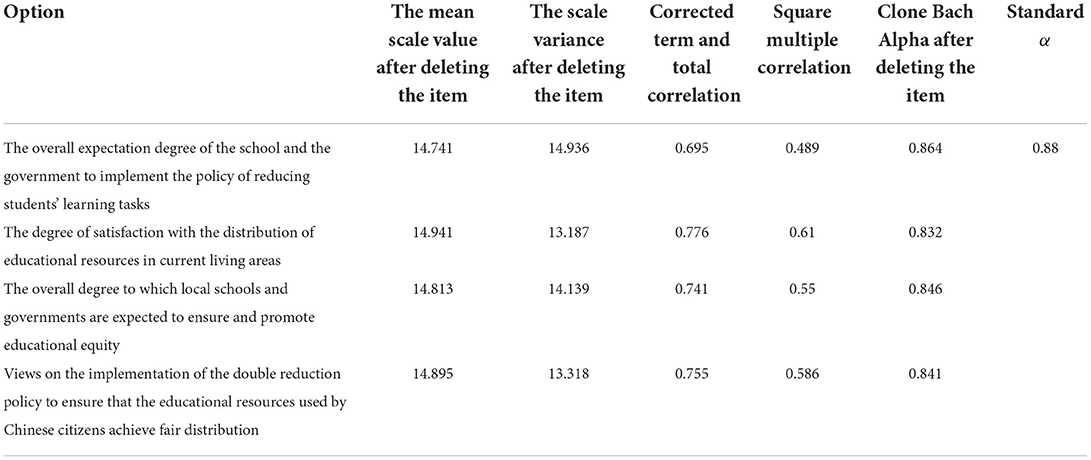
Table 2. Views on whether educational resources can be fairly distributed under the double reduction policy.
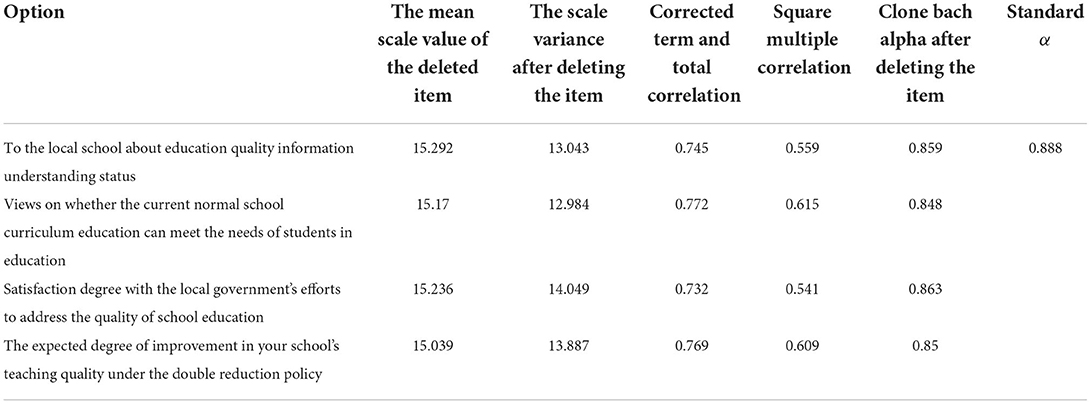
Table 3. Views on whether in-school teaching quality can be guaranteed under the double reduction policy.

Table 4. Views on whether national education and training direction can be diversified under the double reduction policy.
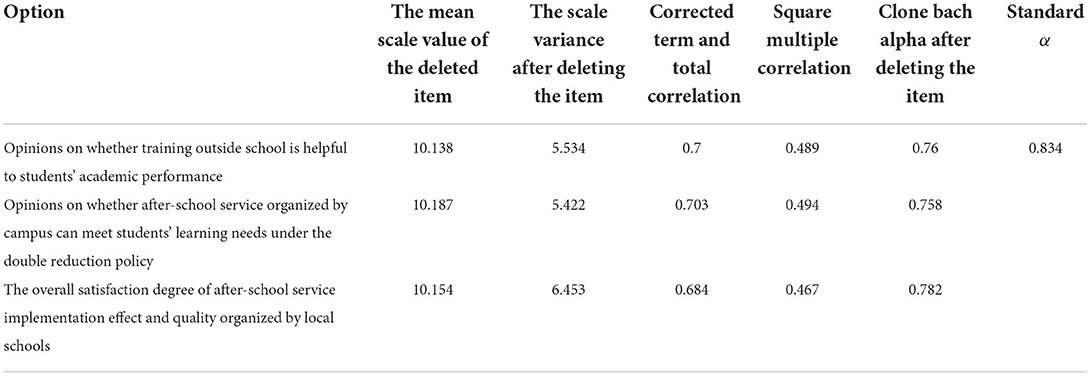
Table 5. Views on whether the governance of off-campus training under the double reduction policy is beneficial to students' learning.
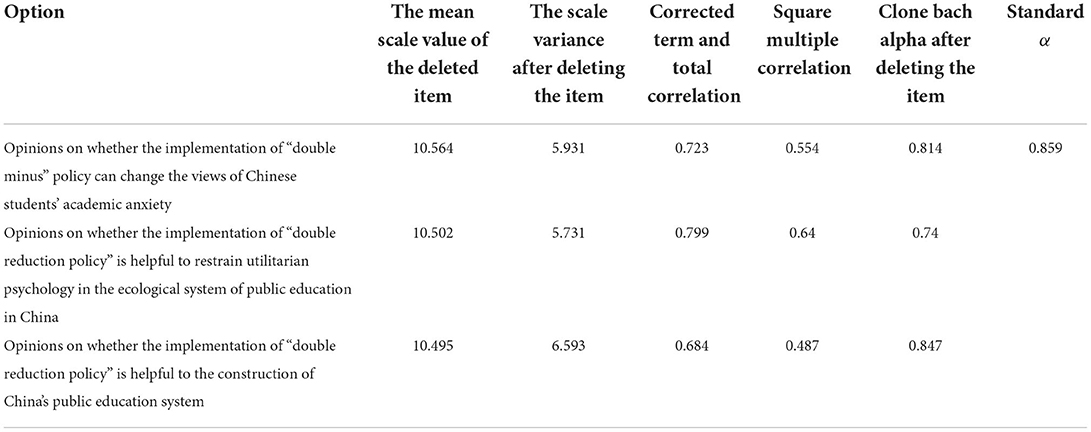
Table 6. Views on whether the double reduction policy can ensure the development of China's public education ecosystem.
According to the overall reliability coefficient in Table 7, the standardized Cronbach's coefficient is 0.966, and the value range of the reliability coefficient is between 0 and 1. The closer the reliability coefficient is to 1, the higher the reliability will be. Therefore, the overall reliability of this questionnaire is very high.
Validity analysis of dimensional data in the questionnaire scale
The SPSS23 software was used to analyze the validity of the questionnaire data of the public on the current education system under the implementation of the double reduction policy, and the method of exploratory factor analysis is used to realize the test process. The specific results are shown in Table 8.
According to the exploratory factor analysis results in Table 8, the coefficient of the Kaiser-Meyer-Olkin (KMO) test is 0.965, and the coefficient of the KMO test ranges from 0 to 1. The closer it is to 1, the better the validity of the questionnaire is. Therefore, the overall validity of this questionnaire is relatively good.
As can be seen from the significance of the spherical test in Table 8, the significance of this test is infinitely close to 0, rejecting the null hypothesis, so the questionnaire has good validity (Lv et al., 2019).
Difference test between dimensional data and non-dimensional data in the questionnaire
By using the SPSS23 software to analyze the difference between the non-dimensional data and the dimensional data in the questionnaire on the public's views on the current education system under the implementation of the double reduction policy, the differences of five dimensional variables in the five non-dimensional data including gender, age, identity, education background, and understanding degree of the double reduction policy were analyzed, respectively. It is concluded that under the five different demographic characteristics of gender, age, identity, education background, and understanding degree of the double reduction policy, there are differences in educational views on the equitable distribution of educational resources, the guarantee of in-school education quality, the diversification of educational training, the governance of out-of-school training, and the public education system.
In terms of gender, adopting the method of independent sample T-test for men and women under double reduction policy fair distribution of education resources, diversification of the quality assurance of school education, education training, training outside governance, and the public education system of the five dimensions of education view differences were analyzed, and the specific data analysis results are shown in Table 9.
According to the results of the independent sample T-test in Table 9, in terms of gender, the significant test values of the differences in the fair distribution of educational resources, the guarantee of school education quality, the diversification of education and training, the governance of after-school training, and the public education system are 0.099, 0.194, 0.462, 0.153, and 0.201, respectively, and these values are significantly >0.05. Therefore, it shows that there are no significant differences in the views of different genders on the five dimensions of education under the double reduction policy: the fair distribution of educational resources, the guarantee of the quality of education in school, the diversification of education and training, and the governance of out of school training and the public education system (Yang, 2022a,b).
In terms of age, identity, educational background, and understanding of the double reduction policy, the one-way ANOVA method is used to analyze the differences in educational views in the five dimensions of fair distribution of educational resources, guarantee of school education quality, diversification of education and training, governance of out of school training, and public education system under the double reduction policy. The specific analysis results are shown in Tables 10–13.
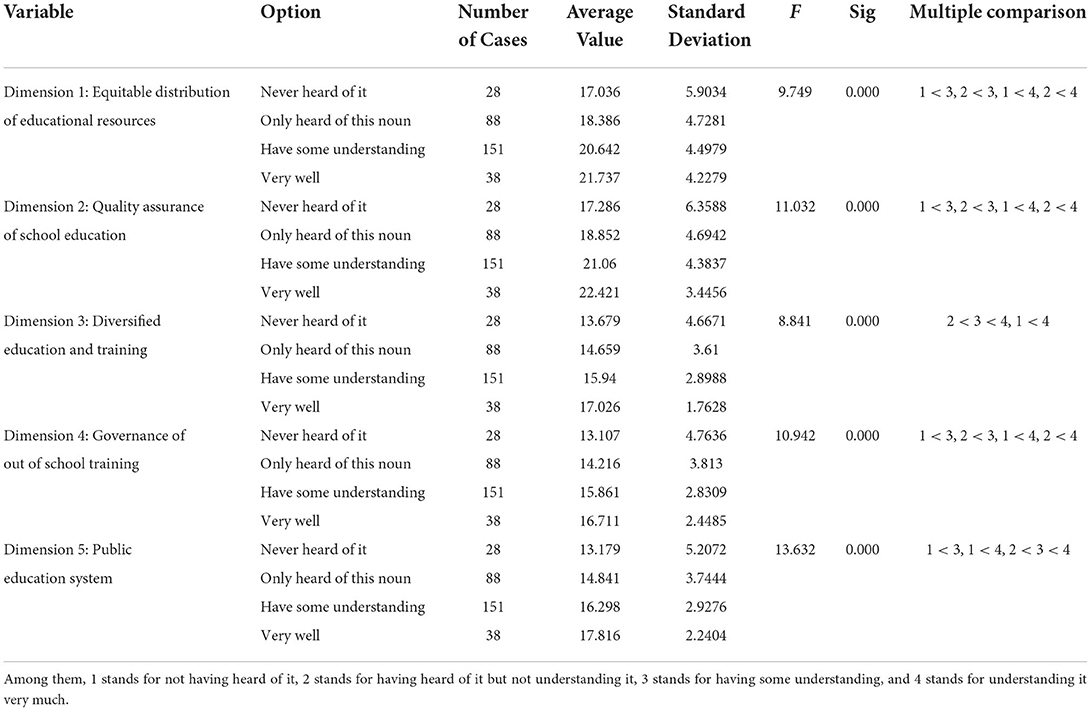
Table 13. Analysis of differences in understanding of the double reduction policy among data of various dimensions.
According to the results of the above one-way ANOVA, we can see that there are differences in educational views on the fair distribution of educational resources, the guarantee of educational quality in schools, and the governance of out-of-school training in terms of age, identity, educational background, and understanding of the double reduction policy. While the diversity of education and training and the public education system have some differences in educational views in terms of academic qualifications and understanding of the double reduction policy, there are no differences in educational views in terms of age and identity. Therefore, there are differences in educational cognitive psychology in all aspects of education under the implementation of the double reduction policy.
According to the results of correlation analysis in Table 14, under the condition of P <0.01, the Pearson coefficient of each dimension variable meets the requirements of significant correlation, so there is a significant correlation between each dimension variable. Therefore, it can provide the prerequisite for the existence of correlation for the construction of the structural equation model.
The structural equation model constructed based on the questionnaire data
Construction of structural equation model
According to the method of confirmatory factor analysis, using the test model tool Amos 24 software to construct the structural equation model of the dimensional data in the questionnaire on the public's opinions on the current education system under the implementation of the double reduction policy, the path coefficient in the structural equation model through the Amos 24 software is calculated, and the influence degree of the dimensional variables of each path in the structural equation model is judged, so as to obtain the social public's psychological views on education under the implementation of the double reduction policy and provide corresponding educational psychological suggestions for the construction of later education system. The structural equation model of public opinion under the double reduction policy is shown in Figure 1.
Then, the path coefficients of the above structural equation model are calculated using the confirmatory factor analysis method using the Amos 24 software to obtain the corresponding Amos structural equation model diagram (Chen et al., 2022). The details are shown in Figure 2.
The structural equation model calculated using the above Amos software is fitted with structural validity and convergence validity. The fitting results are shown in Tables 15, 16.
Based on confirmatory factor analysis, this study uses the Amos software to construct a structural equation model of the public's view on the education system under the implementation of the double reduction policy. According to Table 15, the fitting value of CMIN/DF is 3.005. It is very close to 3, and the adaptation is relatively ideal. The fitting value of RMSEA is 0.081, which is very close to 0.08, and the fitting is relatively ideal. The fitting values of GFI and NFI are 0.883 and 0.925, respectively, which are >0.8, and the results are well matched. The fitting value of CFI is 0.948, >0.9, and the results are well adapted. Therefore, on the whole, the structural equation model of educational cognitive psychology of the public under the implementation of the double reduction policy is well adapted (Wan and Cheng, 2021).
This study analyzes the convergence validity of the data from five dimensions, namely, the development of the education system, the governance of training institutions, the fair distribution of educational resources, the diversification of training methods, and the assurance of educational quality. First, the standardized compliance of each index in the five dimensional data is between 0.7 and 0.9. Second, the combined validity CR values of the five dimensional data are |>0.7, which means that the higher the consistency of internal data, the more convergent. The average variance extraction volume AVE value of the last five dimensions of data is >0.5, which indicates that the potential variables of the five dimensions of data have an average explanatory ability to their corresponding potential variables, so the convergence validity is good. Therefore, the data on the five dimensions of the development of the education system, the governance of training institutions, the fair distribution of educational resources, the diversification of training methods, and the assurance of educational quality under the double reduction policy have convergent validity, so it can be used as a psychological research model for the views of the public on education under the double reduction policy. At the same time, compared with the previous research results on the double reduction policy, using the SPSS software and Amos software to analyze the data in the questionnaire on the public's views on the current education system under the double reduction policy, it is more prominent that this research is based on quantitative analysis. The method is used to explore the psychological cognition of the public about the current education system under the implementation of the double reduction policy.
Research on public psychology based on the results of data analysis
According to the above research results, under the implementation of the double reduction policy, the development of the education system, the governance of training institutions, the fair distribution of educational resources, the diversification of training methods, and the quality assurance of education are the five dimensions of data and the analysis of demographic variables, and the group characteristics of the public collected in this questionnaire are mainly those aged between 29 and 39 years who have received higher education. Female parents who have a certain understanding of the double reduction policy and their views on all aspects of education under the implementation of the double reduction policy are relatively unified, indicating that men and women have the same cognitive psychology of future education under the influence of the double reduction policy.
In terms of the dimensions of fair distribution of education, the guarantee of the quality of in-school education, and the governance of out-of-school training, those over the age of 50 years who have not received higher education do not know much about the double reduction policy and are not the social masses of parents and teachers in their own identity. There are obvious differences between the view of fair distribution of education and that of other mass groups. Finally, on the dimension of educational diversity and public education system, there are obvious psychological differences in educational views among the public who have not received high school education, have received high school education, and have a different understanding of the double reduction policy.
Through the structural equation model of the public's mentality of the current education system under the implementation of the double reduction policy constructed by the quantitative analysis research method, we can see that the public's ultimate psychological vision for domestic education is to achieve fair development of China's public education system, and the public psychological point of view is that through the management of educational courses of training institutions, it can have a good role in promoting the fair distribution of educational resources in China. To achieve the goal of diversifying education and training methods, the fair and just development of the domestic public education system is ultimately ensured.
Conclusion
This study collects data on the public's psychological views on education under the double reduction policy by means of questionnaires and conducts variance analysis and structural equation model tests on the collected data. Education, the public who do not know much about the double reduction policy, and their identity are not parents and teachers. Under the double reduction policy, the public is treated with fair distribution of education, on-campus education quality, off-campus training governance, education and training diversity, and the public education system. These five aspects have different psychological views from other members of the public, and the general psychological view of the public on education is to rectify the education and training industry through the implementation of the “double reduction policy,” in order to ensure the fair distribution of educational resources, to ensure the quality of school education, so as to realize the diversification of education and training methods to ensure the fair and just development of the domestic public education system. Therefore, based on the above-mentioned public opinion on education psychology under the double reduction policy, the following policy suggestions are put forward:
(1) To ensure the balanced development of the domestic education system, it is necessary to popularize the ideological connotation of the double reduction policy to the public, so as to ensure that the older and uneducated social public's lack of understanding of the implementation of the policy can be improved, so as to ensure the public's perception of the education system.
(2) To ensure the balanced development of the domestic education system, it is necessary to rectify the excessive supplementary courses in the education and training industry, so as to ensure the fair distribution of domestic educational resources and the improvement of school education quality and build a fair education system with diversified training methods.
At the same time, this research analyzes the psychological cognition of the public about the current education system under the implementation of the double reduction policy by means of quantitative analysis, so as to provide corresponding insights for the public's psychological cognition research on the current education system under the implementation of the double reduction policy.
Data availability statement
The original contributions presented in the study are included in the article/supplementary material, further inquiries can be directed to the corresponding author/s.
Author contributions
XZ wrote the paper, WZ built the model, and KZ revised the paper. All authors contributed to the article and approved the submitted version.
Conflict of interest
The authors declare that the research was conducted in the absence of any commercial or financial relationships that could be construed as a potential conflict of interest.
Publisher's note
All claims expressed in this article are solely those of the authors and do not necessarily represent those of their affiliated organizations, or those of the publisher, the editors and the reviewers. Any product that may be evaluated in this article, or claim that may be made by its manufacturer, is not guaranteed or endorsed by the publisher.
References
Chen, L., Zhang, J., and Liu, J. (2022). How to promote the online flow of high-quality teacher resources under the “double reduction” policy: an analysis of the influencing factors of teachers' intention to continue to participate in extracurricular online tutoring services. Mod. Distance Educ. Res. 34, 11–20.
Chen, P. (2021). Implementing the requirements of “Double reduction Policy” to improve teaching quality – research on evaluation standard of Junior Middle School Chinese Academic Quality based on core accomplishment. J. Educ. Dev. 2021, 58–64.
Du, X. (2021). On the study of after-school service under the background of “double reduction policy”. J. Xinjiang Normal Univ. (Philos. Soc. Sci. Ed.) 31:1–12.
Huang, B., He, P., Zhu, Y., and Wei, Y. (2022). Differentiation of Chinese family out-of-school education expenditure based on parents' educational background—also on the optimization of “double reduction” policy implementation from the perspective of family demand. China Educ. J. 4, 19–28.
Liu, J. (2021). Motivation of family off-campus training demand and its enlightenment to the implementation of “double reduction” policy. Glob. Educ. Outlook 50, 85–98.
Lv, X., Wang, X., Zhang, H., Liu, Y., Zhang, Y., Wang, J., et al. (2019). Preliminary formulation and reliability and validity test of the Chinese doctor-patient social mentality questionnaire. Psychol. Explor. 39, 57–63.
Ma, K., Wang, G., Fang, F., Zhang, R., Ai, Q., and Li, T. (2021). Educational concept and educational ecological reform under the policy of “Double Reduction” (written discussion). J. Tianjin Normal Univ. (Soc. Sci. Ed.) 6, 1–14.
Ou, Y., and Xue, Q. (2021). The opportunity and path of “Internet +” thinking enabling educational product development under the background of “double reduction policy”. China Publish. J. 24, 54–56.
Wan, L., and Cheng, H. (2021). Research on the behavior factors of scientific data sharing based on meta-analytical structural equation model. Intell. Theory Pract. 44, 125–130 + 158.
Yang, Y. (2022a). Theoretical logic, practical problems and approaches to the implementation of the “Double Reduction” Policy: based on the principle of interest and a large-sample survey of province X. China Electron. Educ. 5, 26–34.
Yang, Y. (2022b). Periodic characteristics and problem analysis of the implementation of the “Double Reduction” policy—based on the investigation of four groups of key stakeholders in X province. J. Yunnan Normal Univ. (Philos. Soc. Sci.) 54, 114–124.
Yu, H. (2021). The public return and fairness of basic education in the “double reduction” era. Soc. Sci. Nanjing, 12, 145–153+ 170.
Yu, T., and Ao, E. (2022). Investigation and analysis of the current situation of mathematics learning of junior three students under the background of “double subtraction” – an example of a middle school in C City, Inner Mongolia Autonomous Region. J. Chifeng Univ. (Nat. Sci. Ed.) 38, 39–42.
Zhang, X., and Gao, X. (2021). Research on the selection of provincial and municipal level burden reduction policy tools under the background of “double reduction” – based on the dual-dimensional analysis of policy tools and types of burden reduction. Basic Educ. 18, 21–30.
Zhang, Z. (2021). Reconstruction and governance of public education system under the pattern of double reduction policy. J. Chin. Soc. Educ. 09, 20–26+ 49.
Keywords: double reduction policy, educational equity, difference analysis, structural model equation, educational psychological cognition
Citation: Zhang X, Zhao W and Zhou K (2022) An empirical analysis of double reduction education policy based on public psychology. Front. Psychol. 13:952719. doi: 10.3389/fpsyg.2022.952719
Received: 25 May 2022; Accepted: 18 July 2022;
Published: 30 August 2022.
Edited by:
Lisete Mónico, University of Coimbra, PortugalReviewed by:
Fakhr E. Alam Afridi, National University of Modern Languages, PakistanTamara Gajić, Serbian Academy of Sciences and Arts, Serbia
Netty Merdiaty, Universitas Bhayangkara Jakarta Raya, Indonesia
Copyright © 2022 Zhang, Zhao and Zhou. This is an open-access article distributed under the terms of the Creative Commons Attribution License (CC BY). The use, distribution or reproduction in other forums is permitted, provided the original author(s) and the copyright owner(s) are credited and that the original publication in this journal is cited, in accordance with accepted academic practice. No use, distribution or reproduction is permitted which does not comply with these terms.
*Correspondence: Weibin Zhao, zwb19951314@163.com
 Xin Zhang1
Xin Zhang1 Weibin Zhao
Weibin Zhao Kai Zhou
Kai Zhou